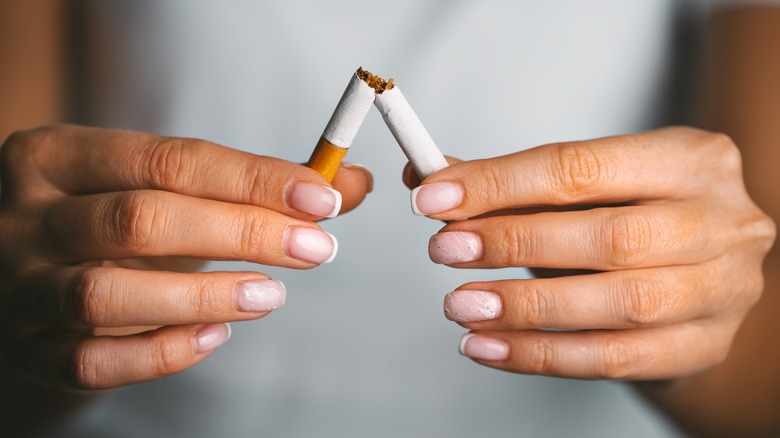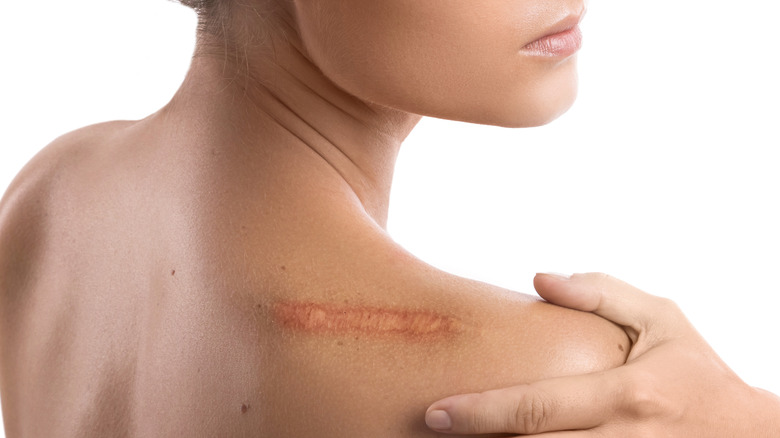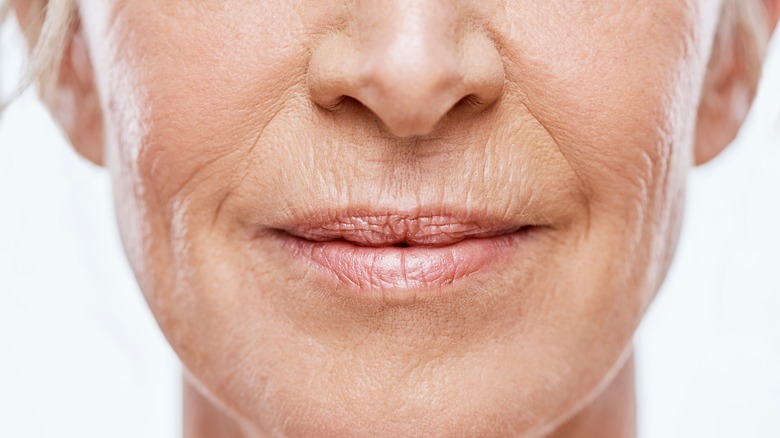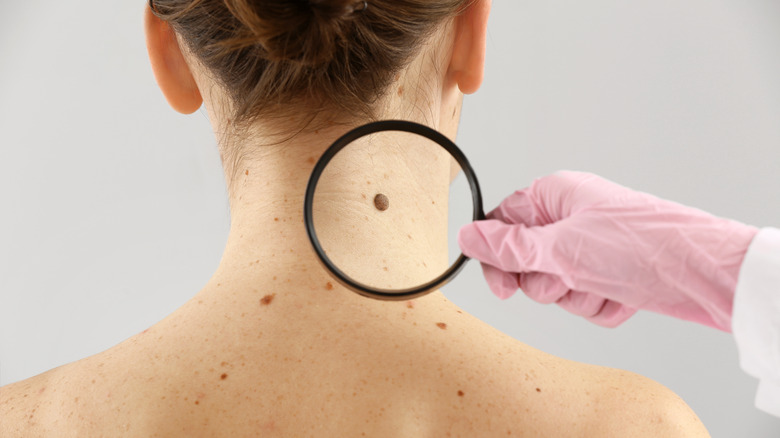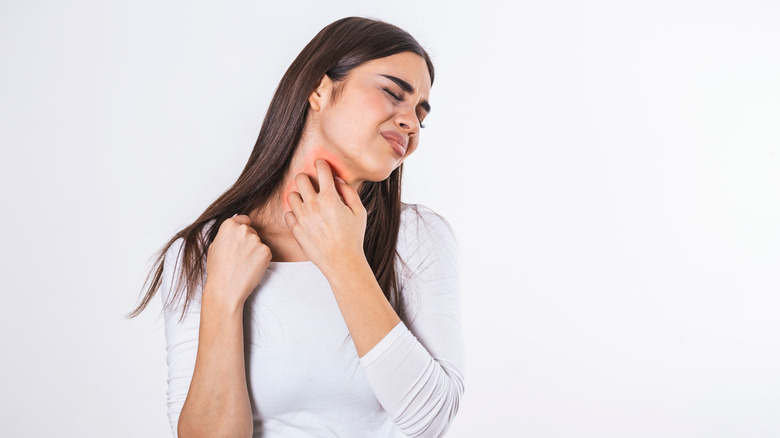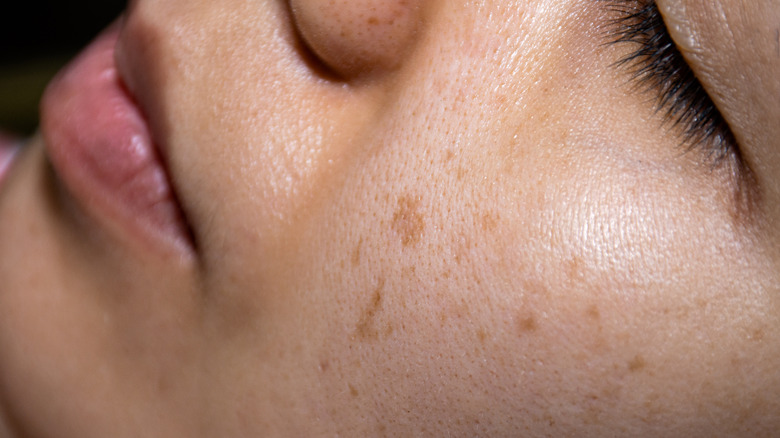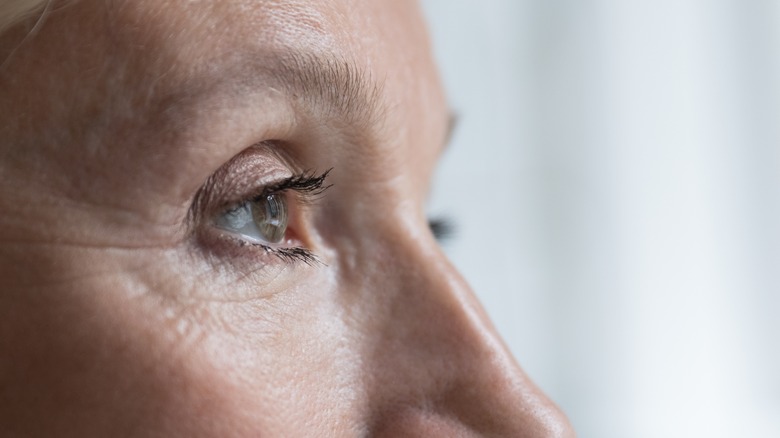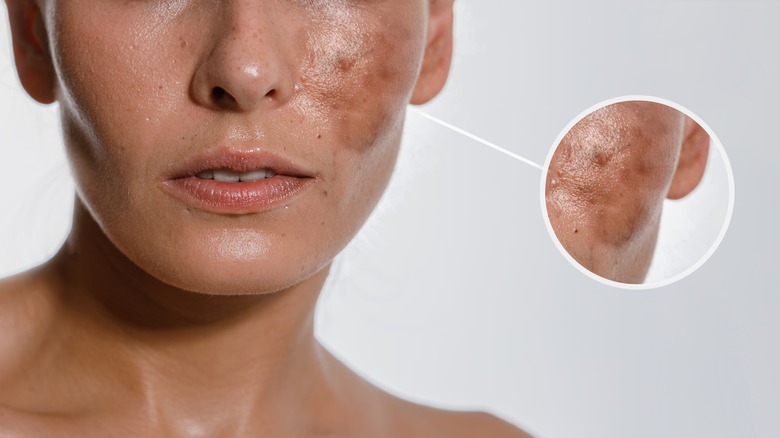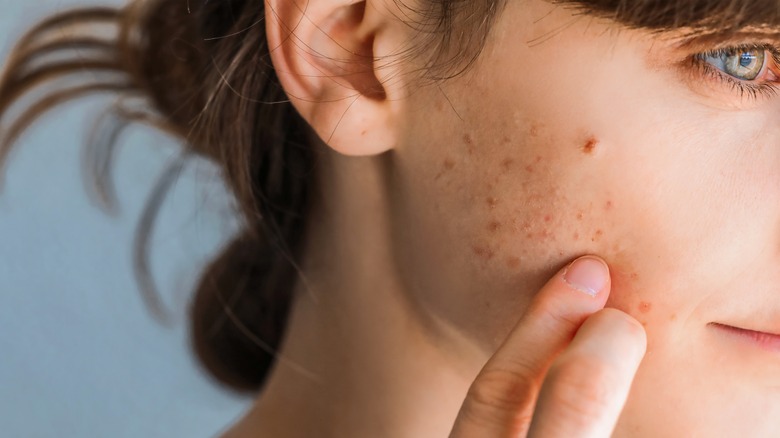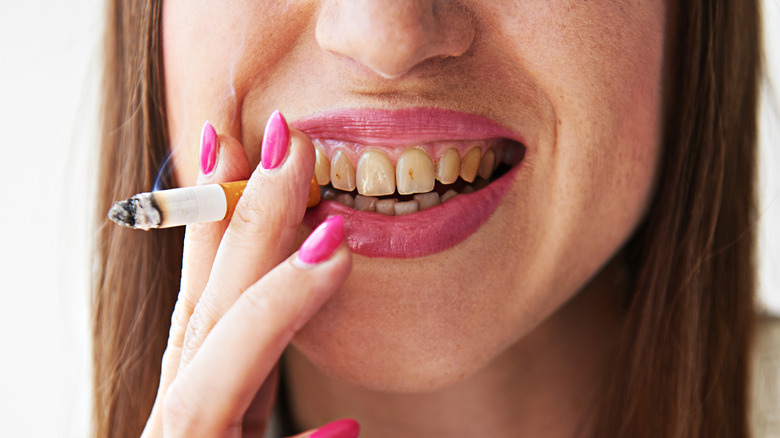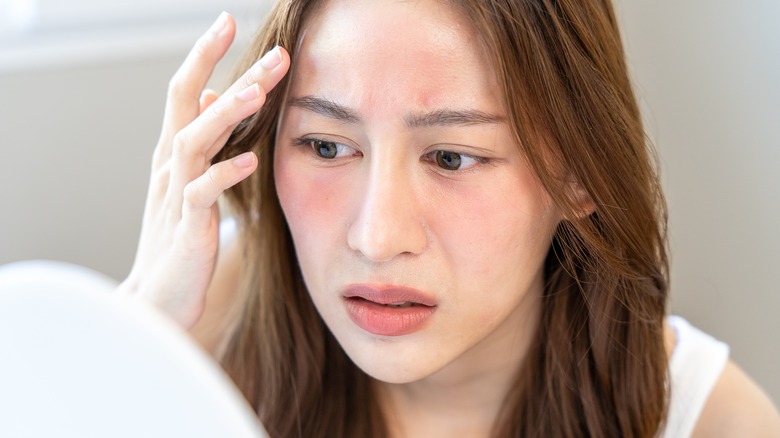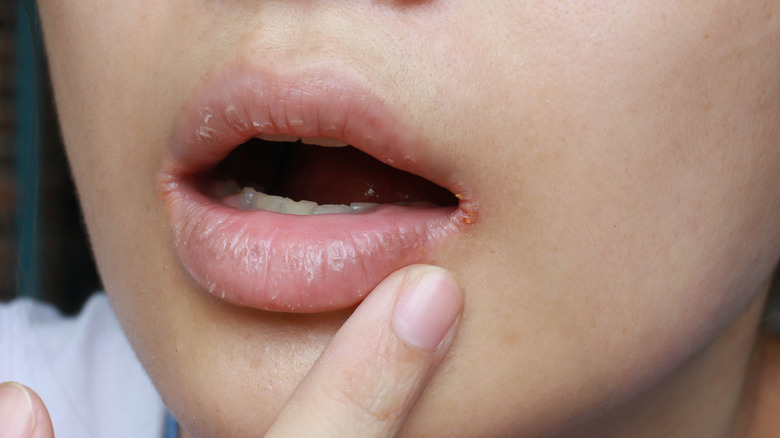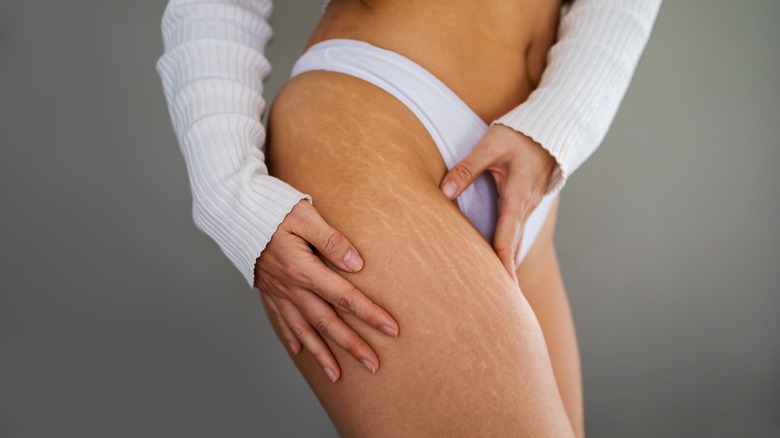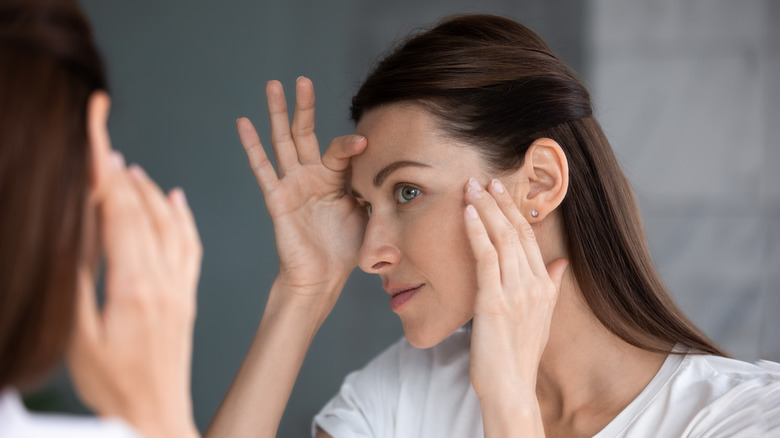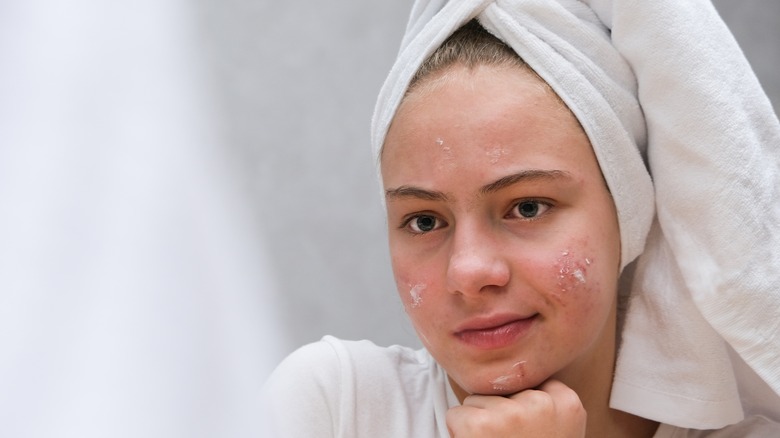The Negative Skin Effects That Will Finally Get You To Stop Smoking
We know smoking can cause severe damage to the lungs and "can increase the risk of developing chronic disorders, cancer, and premature death," according to Advances in Dermatology and Allergology (via National Library of Medicine). In fact, nicotine chewing gum, cigarettes, and cigars all contain tobacco that can cause many health problems. But what about its effect on the skin?
According to The Canadian Lung Association, there are approximately 4,000 chemicals in a cigarette. They can affect your skin in a myriad of ways, from producing dark spots and staining skin yellow to causing deeper wrinkles.
However, it is possible to see changes in your skin within a few days of stopping smoking and using tobacco products. Over time, many negative effects of smoking may be able to be lessened or completely reversed. Does knowing that motivate you to stop this bad habit that harms not just your body, but also your skin? Here are 15 effects that tobacco has on the skin that will finally get you to stop smoking.
Slower wound healing
Whether you're cooking or crafting, gardening, or riding a bike, minor injuries are commonplace when you're just living your life normally. It can take a few days for your body to recover and heal completely from a single cut. But if you are a heavy smoker, cuts, scratches, and other minor injuries can take even longer to heal, per Johns Hopkins Medicine.
When you get hurt, your body fights against bacteria entering your wounds by clotting your blood in order to prevent infection (via Johns Hopkins Medicine). Once your wound is closed, oxygen-rich blood cells deliver fresh nutrients into the wound to help build new tissue and promote healing. However, when you smoke cigarettes, you disrupt your immune system and your blood flow is impacted. As a result, wounds heal much more slowly which can lead to other bacteria coming into contact with the wound, and the risk of infection increases. Additionally, smoking increases blood sugar levels which has multiple effects on the body, including slowing down the wound-healing process.
Mouth wrinkles
It is natural that, with age, your skin naturally loses elasticity and vertical wrinkles around the mouth can form. However, if you are a smoker, these wrinkles tend to show up more quickly. According to Illuminate Skin & Wellness Clinics, these vertical lines are not only due to the puckering of the lips but also to a decrease in the production of collagen and hyaluronic acid, substances naturally present in the body that give the skin strength and volume.
Collagen is a protein that naturally decreases every year after the age of 20, and is vital for having plump, smooth skin, per Cosmetic Skin Clinic. Smoking decreases the production of this protein and wrinkles that occur due to the puckering of the lips appear more quickly than they do on a non-smoker. Although serums and supplements can help counteract the rapid breakdown of collagen and elastin proteins, smokers face too much loss too quickly for them to be as effective as they could be.
Skin cancer
Most of us already know that prolonged sun exposure and not regularly using a good SPF can increase your risk of developing skin cancer, also known as melanoma. But did you know that, according to a study conducted by the International Journal of Epidemiology (via National Library of Medicine), smoking cigarettes can too? In fact, according to the Skin Cancer Foundation, 1 in 5 Americans will develop skin cancer by the age of 70.
Sun exposure and smoking seem to have a synergistic effect. Combining the two can have very harmful consequences for your skin and increases the risk of skin cancer. The chemicals found in cigarettes will affect the DNA that protects you from cancer (via Cancer Research UK). In addition, because smoking can decrease your immune system's ability to fight infections, smokers can't fight melanoma as well as non-smokers, which means that their chances of recovering from melanoma are poorer (per Skin Cancer Foundation).
Psoriasis
Psoriasis, a condition that results in patches of red, rough, itchy skin all over the body, is one of the many diseases that can affect smokers every year, a study conducted by Advances in Dermatology and Allergology showed (via National Library of Medicine).
As the NHS explains, psoriasis causes an overproduction in the formation of skin cells on the body. Smoking can accelerate this process even more. More specifically, nicotine affects the immune system, which can intensify psoriasis by producing an inflammatory reaction in the skin (per Clair Skin Clinic).
In addition to smoking, the other factors that can lead to this condition include stress, drinking alcohol, and experiencing menopause. If you already suffer from this skin condition, smoking can make it even worse. Stopping smoking reduces the inflammatory activity of the body and decreases the risk of developing future cardiovascular complications, such as heart attacks, hypertension, and diabetes.
Uneven complexion
Having a clear, even, glowing complexion is the dream of many. Per Healthline, while staying hydrated, using sunscreen daily, having a regular skincare routine, and having a solid diet can help you achieve an even skin tone, smoking can make you look completely dull. When you smoke, "red blood cells have a hard time getting oxygen to the outer layers of the skin, which results in a pale, dull, grayish complexion," according to SkinKraft Laboratories.
Smoking many cigarettes a day also decreases the production of vitamin A. This vitamin is essential for the skin and helps to give it a radiant glow. Among its many benefits, vitamin A normalizes how cells function, regulates oil production, and normalizes the appearance of pigmentation by affecting the activity of tyrosinase, an enzyme that produces melanin (via Environ).
Thinking about quitting? Freed from the grip of cigarettes, your face will look fresher, your skin will be more even-toned, and you will regain glowing, brighter skin after a few days of stopping.
Sagging skin and deeper wrinkles
Many studies have shown how smoking affects the skin. Among them was one carried out by NBC News which featured multiple sets of twins who were photographed on the same day to show the effects of various factors on their skin, including sun, stress, and yes, smoking. For the sets of twins with a smoker, the difference was significant. On those who smoked several packs a day for many years, the wrinkles are more pronounced and deeper, and the skin on the cheeks, eyes, and neck are saggier, making that twin look older and more tired than their sibling.
According to SkinKraft Laboratories, the toxins in cigarettes affect collagen and elastin production, resulting in a droopy appearance. But the face is not the only area on the body that is affected. The skin on your upper arms can sag and breasts can lose their firmness also.
Skin pigmentation
If your skin already has dark spots or hyperpigmentation, smoking can make your blemishes worse as tobacco is known to contribute to the formation of dark spots on the skin. Arlington Dermatology explains that this change in the normal color of the skin can be hyperpigmented (brown, red, or pink) or hypopigmented (white).
When you smoke, there is an increase in the production of melanin — a skin pigment responsible for the color of eyes, hair, and skin — which creates uneven spots on the skin. Normally, melanin is evenly distributed in the upper layers of the epidermis. However, if the skin is damaged by smoke, it loses its balance (via Eucerin). It starts to produce more free radicals that are responsible for many skin problems, including undesirable skin pigmentation (per Odacite California). However, quitting smoking helps the skin regain its radiance and prevents new spots from appearing.
Eczema
If during your daily skin inspection in front of the mirror, you notice that you have dry, itchy red spots forming on your hands and face, you may have eczema. And if you are a smoker there is a high probability that it is connected to that. In a study called "Tobacco Smoking and Hand Eczema," researchers explain that smokers have a better chance of developing eczema in their lifetime (via East Carolina Dermatology and Skin Surgery, PLLC). The more you smoke, the greater your chances.
Tobacco is an irritating, polluting substance. That pollution can penetrate the skin and damage the barrier. This makes the inflammatory immune system responds and creates atopic eczema. "Atopic eczema causes the skin to become itchy, dry, cracked, and sore," explains the NHS. The skin becomes sensitive and irritated and reacts to many other triggers. These symptoms are irritating and can detrimentally affect a person's daily life.
Dry skin
It's not just lack of moisture, cold winter weather, and a poor diet that can make skin dry. Smoking can also dry out your skin quickly, which is especially concerning if you already have dry skin to begin with. "Tobacco smoke causes oxidative stress so that insufficient oxygen is supplied to the skin resulting in tissue ischemia and blood vessel occlusion," Dr. Susan Simpkin, Medical Registrar at Waikato Hospital in New Zealand said in a published research paper (via DermNet). In other words, cigarettes decrease the amount of water present in the epidermis, leaving the skin significantly undernourished. While skincare moisturizers can retain the water produced by the body in the skin, smoking does not make it easy for them to do so, according to The Aesthetic Guide.
In addition, smoking also reduces the amount of oxygen in the blood vessels (via Alkmene). With blood flow impaired, skin not only becomes dull but also dries out. While hydrating serums can help reduce this effect, they can't fill in such a significant loss of water.
Yellow stains
Many smokers complain about having yellow or gray stains on their fingers, around their lips, and on their teeth. This discoloration is caused by the nicotine present in cigarettes, or more specifically, the tar that it produces in the body. Not only can it appear on the skin of fingers and around the mouth, but it can also discolor entire hands and other parts of the face.
According to Dermatology Center for Skin Health, your skin contains thousands of tiny pores that not only release oils and sweat and produce sebum to moisturize the skin, but also absorb. A cigarette produces more than 4,000 chemical particles (via Healthline), so it is a given that the look of your skin and teeth will be affected by smoking because they are absorbing these chemical components with every puff.
Unfortunately, this discoloration is not easy to hide over time, but with special stain-fighting toothpastes, you may be able to reduce the number of stains on your teeth. However, the best solution is to quit smoking completely.
Damaged skin barrier
The skin's outermost barrier acts to protect the inner layers from external factors such as pollution, cigarette smoke, and car smoke, but it cannot be properly preserved if it is damaged by smoking. Per Be Beautiful.In, tobacco alters the hydrolipidic film of the skin, which makes it particularly sensitive to external irritants.
A study conducted by the Journal of the Society of Cosmetic Chemists demonstrated the effects of cigarette smoke on epidermal barrier quality (via Research Gate). It revealed that "non-smokers demonstrated a significantly lower degree of transepidermal water loss when compared with both active and passive smokers."
If the skin barrier is damaged irritants such as cigarette smoke and other toxins penetrate directly into the epidermis and dermis — the deepest layers of the skin — causing many problems. Moreover, the damage leaves the skin more sensitive, more fragile, and more likely to develop skin problems.
Darkened and cracked lips
When you smoke, your mouth is one of the first body parts that is visibly affected by tobacco and its dozens of toxic chemical components. One of the unique things about smoking is that nicotine can actually stain the skin. "Constant exposure to heat from smoking can lead to darkening and pigmentation of the lips, which also can become dry and coarse," California-based dermatologist Dr. Michael Kassardjian told Insider.
If your complexion is already duller — which, it likely is because of smoking — it is even easier for the lips to get a new shade. When a cigarette is repeatedly brought to the mouth it does a lot of damage to the skin, making the lips duller, stained, and dry.
Healthline reveals that "reduced blood flow and exposure to tar and nicotine can also cause the melanin in your lips to darken, leading to uneven pigmentation."
Stretch marks
Among the numerous ways that cigarettes can affect the skin, stretch marks are a less obvious one. The small zebra-stripe-like marks appear when a person gains or loses weight rapidly, which causes breaks in collagen and elastin. These small waves can be found on many parts of the body, including on the buttocks, chest, arms, and stomach. But gaining or losing weight is not the only way to get stretch marks. Smoking can also cause them.
The chemical and toxic elements in cigarettes damage the elasticity of the skin because they break the skin's fibers (per Global Health & Pharma). It's at this point that tears and stretch marks can begin to appear. Stretch marks can be purple, blue, or even silver (via Healthline), and they gradually become white over time. Once you have these marks, they are typically there for good. While existing stretch marks can only fade, quitting smoking reduces the risk of new ones forming.
Fast aging skin
Over the years, collagen production decreases, so skin has less elasticity. This is a natural process, and many factors come into play when it comes to skin aging: UV rays from the sun, lack of hydration, and, of course, smoking.
Excessive smoking is not only harmful to your lung and cardiovascular health, but it can also speed up the aging process. Also called "the smoker's face," the faces of people who have smoked for more than 10 years is easily recognizable at a glance, according to The British Medical Journal (via National Library of Medicine).
Skin aging, especially on the face, is accentuated by the many toxic ingredients contained in a cigarette. "When an overload of free radicals cannot gradually be destroyed, their accumulation in the body generates a phenomenon called oxidative stress," according to research published in the International Journal of Biomedical Science (via National Library of Medicine). Each puff of smoke releases thousands of free radicals, which will attack the skin cells and cause irreversible damage.
Acne inversa
Acne inversa — scientifically known as Hidradenitis suppurativa — is a skin condition that causes pus-filled boils or abscesses, according to SkinKraft Laboratories. While it may look like common acne, it is very different and very painful. Smokers are more likely to develop it than non-smokers.
A study conducted by the San Gallicano Dermatological Institute in Italy found that smokers are four times more likely to have acne than non-smokers (via Verywell Health). Smoking stimulates skin cell production, which causes the skin to thicken. The thicker your skin gets, the harder it is for dirt and oil to be removed, and the more whiteheads, blackheads, and blemishes you get. This increases the number of pimples, makes them more purulent, and increases the number of scars. Smoking can also worsen acne marks.
This non-inflammatory acne can appear anywhere on the body, but is most often visible on the armpits and the perineum. However, the breasts, genitals, neck, and even the scalp can also be affected, according to the European Journal of Dermatology (via National Library of Medicine).
